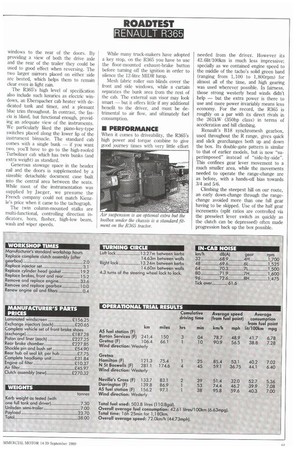ROADTEST RENAULT R365
Page 61

If you've noticed an error in this article please click here to report it so we can fix it.
windows to the rear of the doors. By providing a view of both the drive axle and the rear of the trailer they could be used to good effect when reversing. The two larger mirrors placed on either side are heated, which helps them to remain clear even in light rain.
The R365's high level of specification also include such luxuries as electric windows, an Eberspacher cab heater with dedicated tank and timer, and a pleasant blue trim throughout. In contrast, the fascia is bland, but functional enough, providing an adequate view of the instruments. We particularly liked the piano-key-type switches placed along the lower lip of the instrument binnacle. The standard cab comes with a single bunk if you want two, you'll have to go to the high-roofed Turboliner cab which has twin bunks (and extra weight) as standard.
Generous stowage space in the header rail and the doors is supplemented by a sizeable detachable document case built into the central area between the seats. While most of the instrumentation was supplied by Jaeger, we presume the French company could not match Kienzle's price when it came to the tachograph.
The twin column-mounted stalks are multi-functional, controlling direction indicators, horn, flasher, high-low beam, wash and wiper speeds. While many truck-makers have adopted a key stop, on the R365 you have to use the floor-mounted exhaust-brake button before turning off the ignition in order to silence the 12-litre MIDR lump.
Mesh fabric roller sun blinds cover the front and side windows, while a curtain separates the bunk area from the rest of the cab. The external sun visor may look smart but it offers little if any additional benefit to the driver, and must be detrimental to air flow, and ultimately fuel consumption.
• PERFORMANCE
When it comes to driveability, the R365's high power and torque combine to give good journey times with very little effort
Air suspension is an optional extra but the toolbox under the chassis is a standard fitment on the R365 tractor.
needed from the driver. However its 42.6lit/100km is much less impressive; specially as we contained engine speed to the middle of the tacho's solid green band (ranging from 1,100 to 1,800rpm) for almost all of the time, and high gearing was used wherever possible. In fairness, those strong westerly head winds didn't help but the extra power is there to use and more power invariably means less economy. For the record, the R365 is roughly on a par with its direct rivals in the 261kW (350hp class) in terms of acceleration and hill climbing.
Renault's B18 synchromesh gearbox, used throughout the R range, gives quick and slick gearchanges both up and down the box. Its double-gate pattern is similar to that of earlier models, but is now "superimposed" instead of "side-by-side". This confines gear lever movement to a much smaller area, while the movements needed to operate the range-change are as before, with a hands-off bias towards 3/4 and 5/6.
Climbing the steepest hill on our route, an early down-change through the rangechange avoided more than one full gear having to be skipped. Use of the half gear increments (split ratios are controlled via the preselect lever switch as quickly as the clutch can be depressed) often made progression back up the box possible.






















































































































































